
Ever wonder why big benchers press the way they do? I'll break down the biomechanics behind the most common tenets of bench technique.
Grip and Squeeze
For a competition-style bench, it's recommended that you use a grip as wide as possible as long as it's legal/safe because a wide grip shortens the distance the bar has to travel. This is vital to a big press for several reasons. Before we get into these reasons though, we'll eliminate one common refrain.
Work (in the sense of classical physics) is discussed a lot when it comes to lifting technique, though I think it’s too broad for the talking points of a 1RM bench. The simplicity of the formula—work = force x displacement—doesn’t let you address occasionally contradictory inputs. To be honest, simply trying to reduce work in the bench press can create unintentional disadvantages during a lift. Instead, a lifter needs to identify the components that make up “work” and address these concepts individually.
When work is discussed in strength and conditioning circles outside of the lab, it’s generally (and reasonably) used as an analogue for various kinds of fatigue. We can identify two main kinds of possible fatigue in a 1RM bench: neural and energetic. A shorter distance means less energy expended by the pressing muscles. This means it takes longer for energetic fatigue to set in. While a slight factor in 1RM pressing, the impact of reduced work is very noticeable in tests to failure like the 225 test. This difference is owed to the fact that multiple repetitions are required to deplete ATP stores. Likewise, repeated efforts are needed to bring about neural fatigue. In a 1RM bench (especially in a competition), it would require real recklessness and poor planning on a lifter’s part for a warm up or work-up lift to dampen the nervous system.
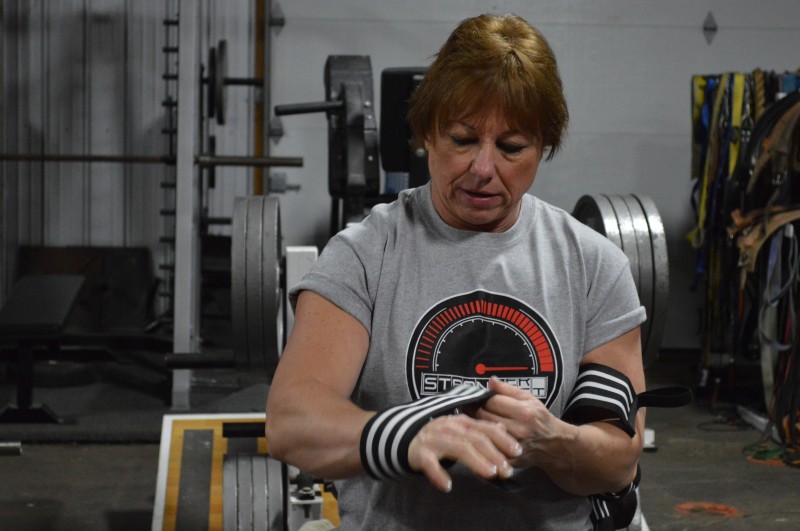
Instead of work, we'll consider the element of time, which is dependent on distance and related to work. A short distance reduces the amount of time that the lift takes to complete. This is an important consideration because muscles achieve their maximum contractive strength about 0.4 seconds into a movement and can maintain this exertion for a brief period of time. Because the triceps and delts are firing very hard from the start to the finish of the lift, a bench press has to be fairly quick to be successful. Anything that reduces the time of the lift is helpful here. In fact, it’s helpful enough to be a recurring theme with bench technique.
Making sure your wide grip is white-knuckle tight does more than keep the bar from rolling off your palms and on to your throat. It’s also a tremendous way to stabilize the bar. I assume that everyone reading this can flex their pecs, biceps and lats without much effort. The number of people who can selectively flex a stabilizer like the infraspinatus is probably a bit lower. This is problematic because waiting for the stabilizers to trigger in response to a load is inefficient. Energy and time are wasted absorbing and reacting to the load and its movement.
Crushing the bar in your hands solves this problem. A tight grip triggers a host of other muscles from the wrists to the hips to tense as well. This is known as muscular irradiation. Irradiation pre-tenses your stabilizers when you unrack the bar, allowing them to immediately control the bar path. A bonus is that prime movers like the triceps are also tensed, allowing them to more effectively control the bar path and absorb energy.
As noted above, one caveat with grip is safety. A wide grip draws the pec tendons tight across the front of the shoulder. This causes additional strain on the tendon, which in turn increases injury risk. By the same turn, a tight, precarious position isn't an effective one for the delts and pecs to produce strength. For this reason, raw benchers generally keep their hands closer—often by several inches—than their geared counterparts. We’ll revisit this topic shortly.
Arch, Pinch and Drive
Arching is another method to shorten the distance that the bar has to travel. It does this by elevating the touch point without also elevating the shoulder joint. The higher touch position caused by arching allows for both a more open elbow and a more elevated arm. Because the upper abdomen is the peak of this arch, it is the best placement for the bar in order to shorten the bar path. However, this may not be the strongest position for you, especially if you bench raw. Arching can also prevent energy leaks and aid in stabilizing the body during the press. The best example is that a tight arch with active use of the spinal erectors and leg drive can prevent the ribs and/or upper back from dropping into the bench. Pressing the bar when the body is falling away is like trying to jump when you’re stuck in a falling elevator—you can’t jump because you have nothing to push off of.
Pinching the scapulae together also has the effect of reducing the bar path and assisting stability. Depressing them is likely more individualized; depressed scapulae can help with a shirted bench groove, though the advantage to a raw lifter isn’t as obvious. Depressing them can move the bar path closer to the apex of your arch, help with shoulder issues and assist a bench shirt groove. On the other hand, setting your scapulae back toward the bench (so that you look like you’re shrugging) essentially lets your shoulders sink into the upper back muscles and provides passive stability.
The higher touch position also improves leverage. Put very simply, the main muscles of the bench press are stronger closer to extension. In the triceps’ case, this occurs when the elbow is more open, and with the pecs/delts, this occurs when the arm is elevated away from the body. The wide grip prevents the elbow from traveling too far back, which in turn increases its opening and physically impedes counterproductive motion of the shoulder.
Finally, while there are many ways to position your legs and feet during the press, lower limb position and drive ultimately aim to aid stability. This is true when you’re wide kneed with your feet far in front of the bench or when you have your toes under your hips and your thighs gripping the bench. An active leg drive reinforces the arch (and an especially active one can help heave the bar off the stomach, though that isn't kosher in most circles).
Pulling the Bar Out
Pulling the bar out of the hooks—as opposed to pressing it out—keeps all the muscles pre-tensed by gripping active.
Because time and work are critical factors in the bench, it might seem that dive-bombing the bar or even actively pulling the bar down would be a lifter’s best technique. That isn’t the case here though.
Besides being illegal in many lifting circles, “dive-bombing” has a few problems. Most importantly, it doesn’t eccentrically load the prime movers. A muscle’s ability to powerfully rebound after an eccentric movement (i.e. the stretch-shortening cycle) requires that the muscle first absorb some force. Dive-bombing can prevent this loading from happening. Dive-bombing can also inadvertently lengthen the bar path by either allowing the bar to sink deeply into the gut or completely collapse a lifter’s arch. Studies confirm that regardless of technique, the body is weak at the bottom of a raw bench. Avoiding the stretch-shortening cycle only exacerbates this weakness.
It’s also advised that the wrists and forearms are locked perpendicularly in relation to the ground. This keeps the elbow joint open at the strongest possible angle for the triceps. If the forearm is tilted toward the head, the joint is more closed. If the forearm is tilted away from the head, gravity takes over and it’s up to the biceps to keep the bar from crushing the lifter’s pelvis.
Though it may seem small, keeping the wrists as straight as possible is a big part of an efficient bench stroke. A wrist that is cocked backward partially negates the leverage gained by a perpendicular forearm. A cocked wrist also isn't as strong as a straight wrist. If the wrist extends during a bench attempt, energy is lost to the flexors and ligaments responsible for keeping the joint from collapsing backward on itself.
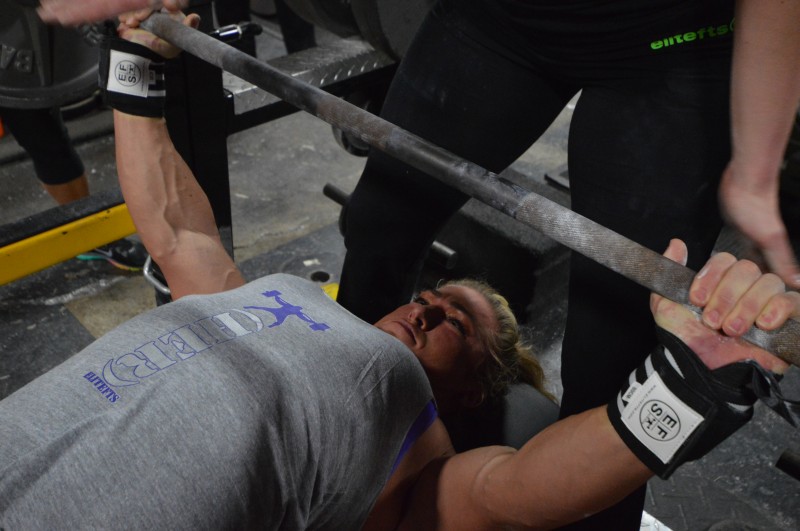
Bar Manipulation
“Pulling the bar apart” is a tried and true method of further engaging the triceps muscles and helping the elbows transition to a more flared position at the end of the press. However, it has a second intriguing aspect to it—it’s a hybrid isometric movement. At the top of the press when the arms are straight or fairly straight, pulling the bar apart is an isometric scapular retraction, with the mid-back muscles working like they’re being asked to do a band pull-apart or a bent fly. As the bar descends and the elbows bend though, the movement adopts a rotational aspect where the external rotators are contracting. The result is that pulling the bar apart helps maintain both upper back tension and shoulder stability.
If you have a mini-band or a piece of elastic tubing handy, you can test this yourself. Take a fairly close double overhand grip on the band and do a partial pull-apart so that your hands move to about the same spacing as you would have during a bench press. Keeping the tension steady, slowly pull the band into your stomach in roughly the same path as you would lower the barbell during a bench press. You’ll feel the activity first between and around your shoulder blades. As you pull the band in, you’ll feel the stress spread to the backs of your shoulders and around your underarms.
But there are other cues for bar manipulation. Trying to bend the bar into a horseshoe shape toward the feet achieves similar isometric results in the shoulder stabilizers. For bodybuilders, squeezing the bar inwards (as if on the pec deck) emphasizes the chest.
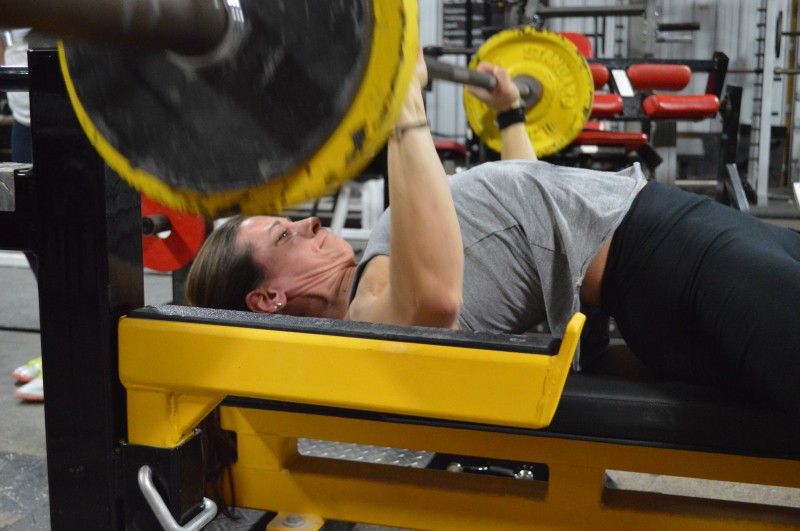
Tucking the Elbows
By necessity, the elbows have to be tucked in order to shorten the bar path. If they flare slightly, the bar touches closer to the head and disadvantages the triceps. If they flare greatly, the bar lands on the slope of the chest, which lengthens the bar path and shifts the load to the pectoral muscles. The shoulder joint is also more stable with the arm positioned near the body, so a tucked position reduces energy lost through a wobbly bar and reduces strain on the ligaments and tendons of the anterior shoulder.
You might be wondering just how tucked elbows and a strong isometric external rotation can co-exist with the pectoral muscles helping in the bottom of the press. If you’re pretty new to power-style benching in general, you’re probably wondering just why I haven’t mentioned the pecs much at all. Sure, there are anatomical rules and features involving insertions that can cause seemingly antagonistic muscles to work in unison, but the truth is simpler—most of today’s top-level pressers deemphasize the pecs during the bench press.
The pectorals are precariously positioned during the bench press. A strong position for the pecs to contract is also a position where the shoulder is open and the muscle’s tendon is in a risky position. (Bench shirts were ostensibly designed to protect the shoulder in this vulnerable position.) It’s also a weak position for the triceps and delts, which is effectively a two-for-one reduction in available muscle groups.
Speaking of shirts, there are differences between shirted and raw pressing, though the focus is the same for most lifters—to keep the triceps engaged and rely on the deltoids to move the bar back to the rack. Raw pressers (particularly ones with shallow arches or thin torsos) will use more chest musculature because they don’t have the enforced groove and pop of shirted benchers, though at most, they generally keep their humeri at about a 45-degree angle to the body. Lifters in federations that require a strict pause will generally lean toward that wider angle so that the pecs can provide more active help at the bottom, though the same lifters will still employ many of the techniques noted above.
Concentric Path
Press straight up or throw the bar back? There’s a case to be made for either approach. The straight press keeps emphasis on the triceps, shortens the bar path, makes locking the wrists easier and reduces shoulder rotation. Throwing the bar back shifts emphasis to the delts in a manner that might provide better leverage during the sticking point.
Because lifters struggling with a heavy weight often throw the bar back at a sticking point, it has been argued that this is a more naturally effective position. It may be true, though I don’t think gleaning technique ideas from a compromised state is the most reasonable approach. An analysis of Bill Kazmaier’s bench technique when compared with less-talented lifters indicated that he heaved the weight backward at the start of the lift. However, Kazmaier’s own bench manual showed that his ideal technique was less aggressive with the throwback. At the same time, several studies have observed that the elbow muscles were the first to fatigue during repeated presses. It may be that too strenuous a warm up can lead to one’s technique becoming more of a throwback style, even if it might not be optimal. Regardless of the bar path, flaring the elbows is recommended at lockout so as to put the elbows in a stronger position.
The Sticking Point
Believe it or not, researchers aren’t sure why there’s a sticking point in the bench press. One theory holds that the sticking point is simply an area of maximal mechanical disadvantage while another postulates that the sticking point is caused by a loss of the stretch-shortening cycle effect and the brief moment of inefficiency that occurs when your central nervous system adjusts to the change. Fortunately, neither theory is reason to shy away from tried and true advice on advancing your bench through slow spots with speed lifts, “dead” benches and technique refinement.
Wrapping Up
If there is one word that has been repeated pretty consistently here, it’s “individualized” as well as its variations.
Much of a lifter’s bench technique is a matter of personal preference as informed by body structure, supportive equipment and health. This individualized approach is supported by Kristiansen and colleagues, who found that a cohort of nationally ranked Danish lifters “apply more individualized motor strategies in bench press” than do untrained subjects. Basically, one of the keys to benching big is adapting your technique to your body. This is true for novices as well as for pros. If there’s a “secret” to big lifts, that’s probably it.
References
- Huang, et al (2014) Elbow joint fatigue and bench press training. J Athl Train 49(3):317–21.
- Kristiansen, et al (2013) Inter-subject variability of muscle synergies during bench press in powerlifters and untrained individuals. Scan J of Sci and Med in Sports. December.
- Miyaguchi, Demura (2006) Muscle power output properties using the stretch-shortening cycle of the upper limb and their relationships with a one-repetition maximum bench press. J Physiol Anthropol 25(3):239–45.
- Silver, et al (2009) Effects of the bench shirt on sagittal bar path. J Strength Cond Res 23(4):1125–8.
- van den Tillar, Ettema (2013) A comparison of muscle activity in concentric and counter movement maximum bench press. J Hum Kinet 8(38):63–71.
- van den Tillar, Ettema (2009) A comparison of successful and unsuccessful attempts in maximal bench pressing. Med Sci Sports Exerc 41(11):2056–63.
- van den Tillar, Ettema (2010) The “sticking period” in a maximum bench press. J Sports Sci 28(5):529–35
- van den Tillar, Saeterbakken (2013) Fatigue effects upon sticking region and electromyography in a six-repetition maximum bench press. J Sports Sci 31(16):1823–30.
- Wattanaprakornkul, et al (2011) Direction-specific recruitment of rotator cuff muscles during bench press and row. J of EMG and Kinesiology 21(6):1041–49.









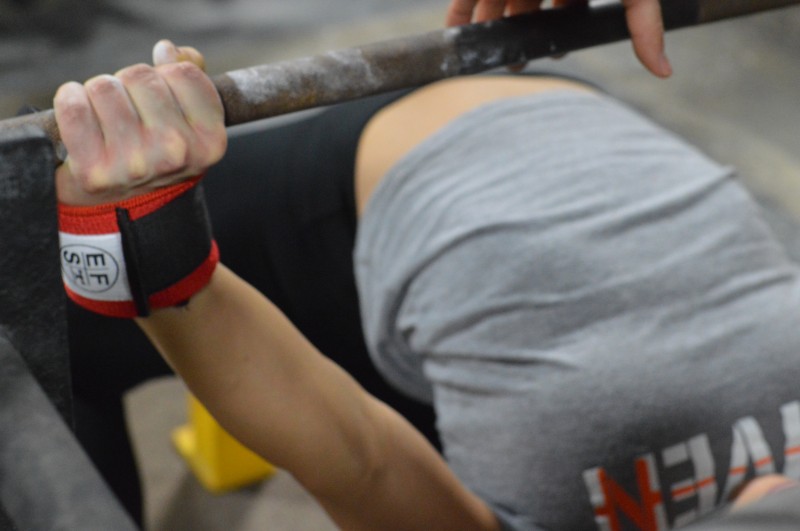
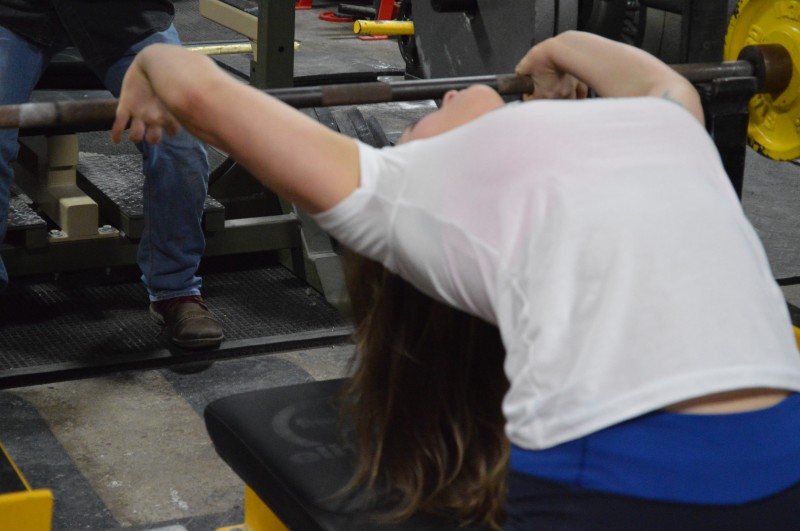
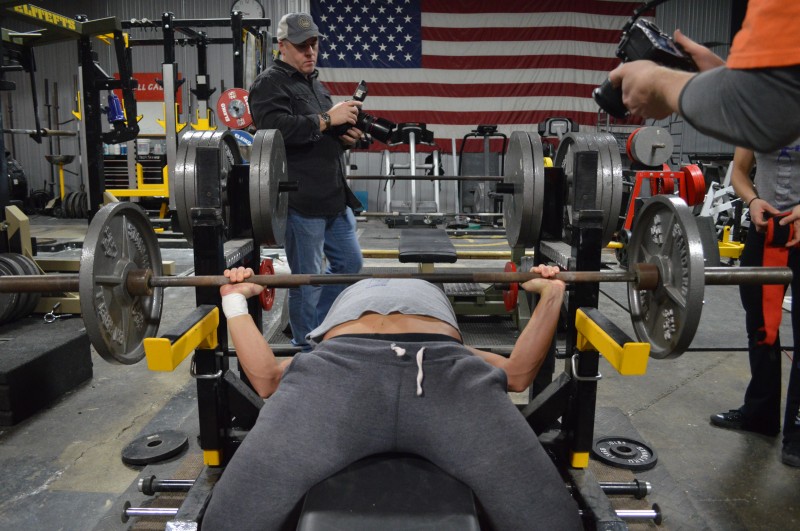


3 Comments